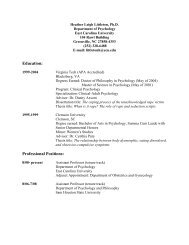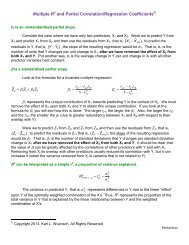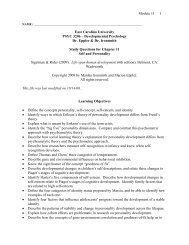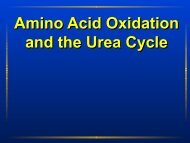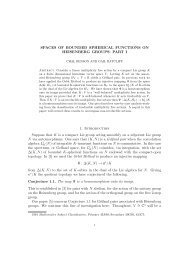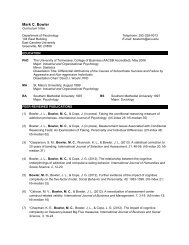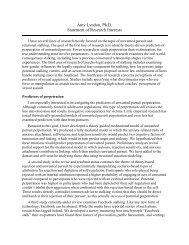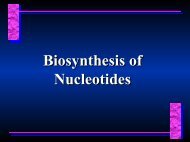304J. J. LUCZKOVICH ET AL.formally def<strong>in</strong>ed. Elton (1927) first def<strong>in</strong>ed theniche as the fundamental role of an organism <strong>in</strong>its community F largely <strong>in</strong> its relation to food<strong>and</strong> to enemies. In def<strong>in</strong><strong>in</strong>g a species’ role <strong>in</strong> thecommunity, Elton drew an analogy with socialroles <strong>in</strong> human communities. S<strong>in</strong>ce that earlydef<strong>in</strong>ition, numerous authors have discussedideas related to trophic role, def<strong>in</strong><strong>in</strong>g <strong>and</strong> us<strong>in</strong>gdifferent terms such as trophic level (L<strong>in</strong>demann,1942), trophic niche (Hutch<strong>in</strong>son, 1958), ecologicalguild (Root, 1967), <strong>and</strong> trophospecies(Yodzis, 1988). Although each of these terms <strong>in</strong>some way def<strong>in</strong>es a species’ trophic role <strong>in</strong> anecosystem, each concept differs slightly, <strong>and</strong>none is completely satisfactory <strong>in</strong> captur<strong>in</strong>g thetotal feed<strong>in</strong>g relations of a species <strong>in</strong> a food web(Cous<strong>in</strong>s, 1985, 1987; Perrson et al., 1996). Here,we formally def<strong>in</strong>e the trophic role of a speciesus<strong>in</strong>g a concept drawn fromsocial role analysiscalled regular equivalence, <strong>and</strong> present examplesus<strong>in</strong>g this approach to measur<strong>in</strong>g similarity <strong>in</strong>the trophic role of species <strong>in</strong> food webs.Recently, some new approaches to the def<strong>in</strong>ition<strong>and</strong> measurement of the trophic role of aspecies <strong>in</strong> a food web have been proposed, <strong>in</strong>which both predator <strong>and</strong> prey relations areconsidered (Goldwasser & Roughgarden, 1993).Yodzis & W<strong>in</strong>emiller (1999) used Jaccard’s(1900) similarity coefficient to operationallydef<strong>in</strong>e trophospecies, first comput<strong>in</strong>g predatorrelations, then prey relations, <strong>and</strong> f<strong>in</strong>ally bothsets of relations at the same time. Given thematrix of species-by-species Jaccard similaritycoefficients, they used cluster<strong>in</strong>g algorithms toidentify classes of species of fishes <strong>in</strong> an aquaticfood web <strong>in</strong> a Venezuelan floodpla<strong>in</strong>. Theyconsidered two separate sets of a species’ l<strong>in</strong>ksto other species (us<strong>in</strong>g both topological <strong>and</strong>energy flow l<strong>in</strong>ks <strong>in</strong> separate analyses), firstcomput<strong>in</strong>g the similarity of predator l<strong>in</strong>ks, thencomput<strong>in</strong>g the similarity of prey l<strong>in</strong>ks, thenmultiply<strong>in</strong>g the similarity measures F what theycalled the multiplicative similarity. They alsoanalysed trophic similarity by ignor<strong>in</strong>g thedist<strong>in</strong>ction between predator <strong>and</strong> prey, simultaneouslycomput<strong>in</strong>g similarity <strong>in</strong> the dual roleeach species played as a consumer <strong>and</strong> a resourceF what they called the additive similarity. Theyconcluded that the additive similarity measureprovided the best measure of trophic similaritybased on predator <strong>and</strong> prey relations. TheYodzis–W<strong>in</strong>emiller approach is an importantadvance because it formalizes a fundamentalconcept (provid<strong>in</strong>g all the associated benefits ofprecision <strong>and</strong> measurability), <strong>and</strong> because it<strong>in</strong>corporates connections up <strong>and</strong> down the foodweb. However, it also reta<strong>in</strong>s an importantweakness <strong>in</strong> the classical conceptualization oftrophic role: it fails to detect the equivalence ofroles of species that do not share the samepredators <strong>and</strong> prey, but that may be similar <strong>in</strong>their trophic position.As an example, consider two species of <strong>in</strong>sectthat serve as prey for two different species ofcongeneric birds, <strong>and</strong> which consume verysimilar, congeneric species of plants. In theYodzis–W<strong>in</strong>emiller approach, these two <strong>in</strong>sectspecies would be placed <strong>in</strong> separate trophicgroups because they share no predators <strong>and</strong> noprey. Yet this measure misses the similarity at ahigher level of trophic organization: both specieshave a similar trophic position with<strong>in</strong> the foodweb. Both <strong>in</strong>sects are functional herbivores, <strong>and</strong>they are eaten by very similar species, but thereis no way for the Yodzis–W<strong>in</strong>emiller approachto detect that these two have any more <strong>in</strong>common than any r<strong>and</strong>om pair of species thatalso share no prey or predators. One solutionwould be to modify the Yodzis–W<strong>in</strong>emillerapproach to measure similarity not at the specieslevel but at a more aggregate level. For example,<strong>in</strong> comput<strong>in</strong>g the shared prey coefficient for each<strong>in</strong>sect species, we could hypothetically count nothow many species they have <strong>in</strong> common, buthow many genera they eat <strong>in</strong> common. Similarly,<strong>in</strong> comput<strong>in</strong>g the shared predator coefficient, wecould count the number of shared bird generathey have <strong>in</strong> common. The obvious problem withthis is that we do not know that the genus is theright level of aggregation, nor do we have anybasis for choos<strong>in</strong>g phylogenetic affiliation as thebasis for group<strong>in</strong>g. However, the general ideais right: to evaluate the trophic similarity of twospecies, we want to know whether they havesimilar trophic ties to the same types of species,but not necessarily the same species. Thequestion is how to def<strong>in</strong>e these types. Ideally,we would use trophospecies F groups of speciesthat are trophically equivalent. But this wouldseemto require know<strong>in</strong>g the answer <strong>in</strong> order to
DEFINITION OF TROPHIC ROLE SIMILARITY 305construct the answer. We are try<strong>in</strong>g to groupspecies <strong>in</strong>to trophically equivalent sets, yet to dothis for any given pair of species, we would liketo know which trophic equivalence set all of theother species belong to, which is circular.Surpris<strong>in</strong>gly, there is a solution, which isrecursive <strong>in</strong> nature; <strong>and</strong>, it is drawn fromthesocial sciences, where the concept of social roleof <strong>in</strong>dividuals with<strong>in</strong> social systems has beenextensively analysed.The social sciences have paid much attentionto the importance of structure <strong>and</strong> position <strong>in</strong>the study of social roles. Social scientists havedevoted a considerable amount of effort toformaliz<strong>in</strong>g the notion of role <strong>in</strong> the contextof a systemof social relations (Nadel, 1957;Merton, 1959; Homans, 1961; Goodenough,1969; Mayhew, 1980). For example, <strong>in</strong> thesystemof social relations <strong>in</strong> a hospital, whatdef<strong>in</strong>es a person as play<strong>in</strong>g the role of doctor isthe characteristic set of relations they have withpersons who are play<strong>in</strong>g related roles such aspatients, nurses, medical record keepers, pharmaceuticalsales people <strong>and</strong> receptionists. Earlysocial network research modeled k<strong>in</strong>ship systemsus<strong>in</strong>g algebraic approaches (White, 1963; Boyd,1969), followed by Lorra<strong>in</strong> & White’s (1971)‘‘structural equivalence’’ concept that formallydef<strong>in</strong>ed roles <strong>and</strong> reduced the complexity of anetwork of relations to a set of simplified rolestructures. In this structural equivalence model,two <strong>in</strong>dividuals are seen as occupy<strong>in</strong>g the sameposition to the extent they have the same k<strong>in</strong>dsof social ties to the same third parties. This work<strong>in</strong> turn paved the way for the development of amore general concept known as regular equivalence(White & Reitz, 1983), <strong>in</strong> which two<strong>in</strong>dividuals are seen as play<strong>in</strong>g the same role tothe extent they have similar ties to analogous<strong>in</strong>dividuals (i.e. those play<strong>in</strong>g correspond<strong>in</strong>groles). Differences between structural <strong>and</strong> regularequivalence approaches were discussed byBorgatti & Everett (1989), Everett & Borgatti(1991) <strong>and</strong> Everett & Borgatti (1994).As an extension of Elton’s (1927) ‘‘role <strong>in</strong>relation to food <strong>and</strong> enemies’’ paradigm, we willnow apply the theory of social role analysis <strong>and</strong>the concept of regular equivalence to ecologicalfood webs <strong>and</strong> formalize the measurements oftrophic role similarity <strong>in</strong> detail. We will apply theregular equivalence approach to the analysis oftrophic role structure <strong>in</strong> two food webs, one ab<strong>in</strong>ary or topological network <strong>and</strong> the othera carbon-flow network. We will also compareperformance of the regular equivalence approachwith the structural method proposedrecently (Yodzis & W<strong>in</strong>emiller, 1999) <strong>in</strong> creat<strong>in</strong>gtrophic aggregations. F<strong>in</strong>ally, we will present animage graph of each food web, based on theregular equivalence approach, which provides areduced-complexity view of the entire food web.2. Theory of <strong>Role</strong> Analysis2.1. GRAPH-THEORETIC TERMINOLOGYWe represent community food web data asa directed graph, or digraph, G(V,E), whichconsists of a set of nodes V (also known asvertices) represent<strong>in</strong>g species or compartments,<strong>and</strong> a set of directed ties (also known as edges orarcs) E which represent predation, parasitismorany other trophic relationship. The notation(a,b) A E <strong>in</strong>dicates the presence of a tie from a tob. Similarly, (b,a) A E, <strong>in</strong>dicates a tie from b to a.Optionally, we can also def<strong>in</strong>e a real-valuedfunction F on E which assigns a value (such as aquantity of flow) to each tie, so that f (u,v)¼ 0.27 would <strong>in</strong>dicate a flow of 0.27 units fromu to v. For simplicity of exposition, we shallusually assume here that ties are simply presentor absent rather than valued. However, themathematics generalizes straightforwardly tovalued data, <strong>and</strong> we will use valued energy flowdata <strong>in</strong> our empirical examples.The set of nodes adjacent to a given node v iscalled the neighborhood of v <strong>and</strong> denoted N(v).In a directed graph, a node’s neighborhoodconsists of two parts: an out-neighborhood,def<strong>in</strong>ed as the set N o (v) ¼ { p| (v, p) A E}, <strong>and</strong>an <strong>in</strong>-neighborhood, def<strong>in</strong>ed as the set N i (v) ¼{q|(q,v) A E}. In the case of food web predationdata, the out-neighborhood N o (u) is the set ofspecies that are predators of species u, <strong>and</strong> the<strong>in</strong>-neighborhood N i (u) is the set of species thatare prey of species u.An equivalence relation def<strong>in</strong>ed on a set ofnodes is a b<strong>in</strong>ary relation that is reflexive,symmetric <strong>and</strong> transitive. An example of anequivalence relation is the relation R <strong>in</strong>duced bya partition of nodes <strong>in</strong>to mutually exclusive



